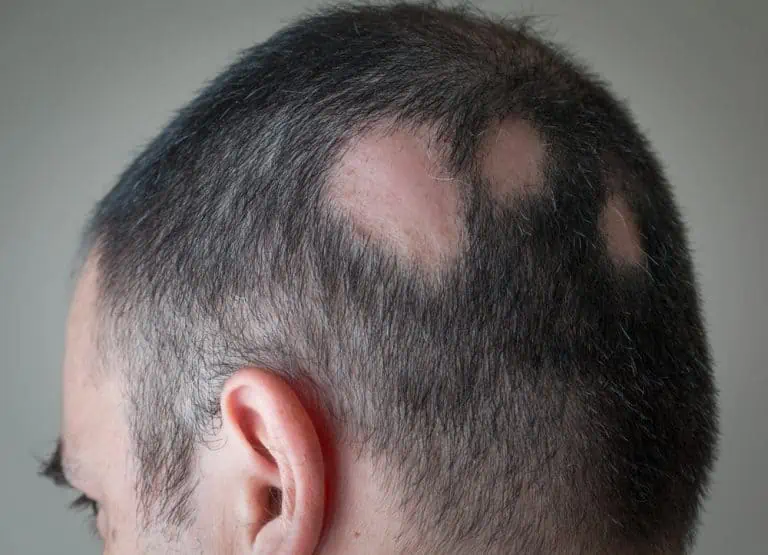What Is Alopecia Areata and Could You Have This Autoimmune Hair Loss Condition?

Most men and many women will experience hair loss, or alopecia, at some point in their lifetime. Often it’s due to male-pattern or female-pattern baldness or hairstyles that pull the hair too hard. But for nearly 7 million people, including children, bald patches in hair appear out of the blue. The likely cause: an autoimmune hair loss disorder called alopecia areata.
What is alopecia areata?
Alopecia areata occurs when the immune system mistakenly attacks hair follicles, the openings in the skin through which hair grows. These attacks trigger inflammation, which causes the follicles to shrink and slows the production of hair. Hair production can eventually stop altogether.
It’s unclear what causes alopecia areata. Genetics probably plays a role, since the condition often runs in families. It sometimes happens after pregnancy, trauma or significant stress, but usually there’s no obvious trigger.
Because it’s such a visible condition, alopecia areata can be tough to live with. There are plenty of treatment options, though, so if you start finding clumps of hair in your comb or swirling toward the drain when you shampoo, or you notice smooth, shiny, hairless areas on your head, see your dermatologist.
Alopecia areata symptoms
Alopecia areata causes patchy hair loss on the scalp and often on other parts of the body, including the beard area, eyebrows, eyelashes, armpits and pubic area. It can sometimes result in total baldness (alopecia totalis). Even hair follicles inside the nose and ears can be affected. Some people with alopecia areata also develop ridges or pitting (tiny dents) on their fingernails and toenails.
In the most severe cases, all or nearly all of the hair on the body is lost. This type of alopecia areata (alopecia universalis) is rare.
Alopecia areata can have several distinctive characteristics:
- Round or oval bald patches in the hair of the scalp. The skin where the hair has fallen out tends to be smooth and may be peach-colored.
- Small bald patches that merge together to form larger ones. Sometimes one patch will fill in with new hair while a new bald patch forms. The new growth is often white or grey, but it usually returns to your hair’s original color.
- Short, broken hairs shaped like exclamation points (narrow at the base and wider at the top) around the edges of the patches. You would need a magnifying glass to see this.
Some people experience tingling, itching or a burning sensation just before hair falls out.
How long does an episode of alopecia areata last?
Alopecia areata is highly unpredictable. Some people may lose and regrow hair in different areas on and off for many years. Others may get back all their hair after a few months, especially if they don’t have widespread hair loss. If a person loses all the hair on their head and/or their body, it typically happens very fast — within six months.
Alopecia areata treatment
Some alopecia areata treatments work by interrupting the immune system attacks that stifle hair growth. Others directly stimulate the growth of new hair.
Topical medications
Topical medications include minoxidil (Rogaine and others), anthralin (a tar-like substance) and topical corticosteroids. Sometimes two or more topical medications are used at the same time. For example, minoxidil alone is rarely effective for alopecia areata but in some cases it works well when combined with a corticosteroid.
Injectable corticosteroids
A dermatologist administers these shots directly into bald areas, typically every four to six weeks. They’re safe and can be highly effective for people with just a few bald patches. A possible side effect are small dents in the scalp called dells, which eventually go away.
Oral corticosteroids
Oral corticosteroids are sometimes prescribed to treat widespread alopecia areata. Long-term use of these drugs poses serious side effects.
Topical immunotherapy medications
These medicines, intended for widespread or rapid autoimmune hair loss, work by causing a rash that changes how the immune system behaves, but they aren’t widely used. They include diphencyprone (DPCP), dinitrochlorobenzene (DNCB) and squaric acid dibutyl ester (SADBE).
Immunomodulators
Immunomodulators are oral medications that either stimulate or suppress the immune system. Most, including methotrexate, are designed to treat autoimmune conditions other than alopecia areata and are prescribed off-label to treat this form of hair loss.
The exception is Olumiant (baricitinib), the newest alopecia areata medication. It’s a kind of immunomodulator called a JAK inhibitor and was originally developed to treat rheumatoid arthritis. The Food and Drug Administration approved it in June 2022 for adults with severe alopecia areata. In clinical trials, some people got back 80% of the hair on their scalp after taking Olumiant for 36 weeks.
In time, more immunomodulators may become available for autoimmune hair loss.
The best way to deal with alopecia areata is to see a dermatologist, who can develop a custom treatment plan. While you’re waiting for treatment to work, consider wearing a wig or hairpiece if your bald patches are making you embarrassed or depressed, and protect bald areas exposed to the sun or cold with a hat or other cover-up.
Medically reviewed by Dunnett Durando, DO
Written by Maura Rhodes, a health writer and editor based in Montclair, New Jersey


